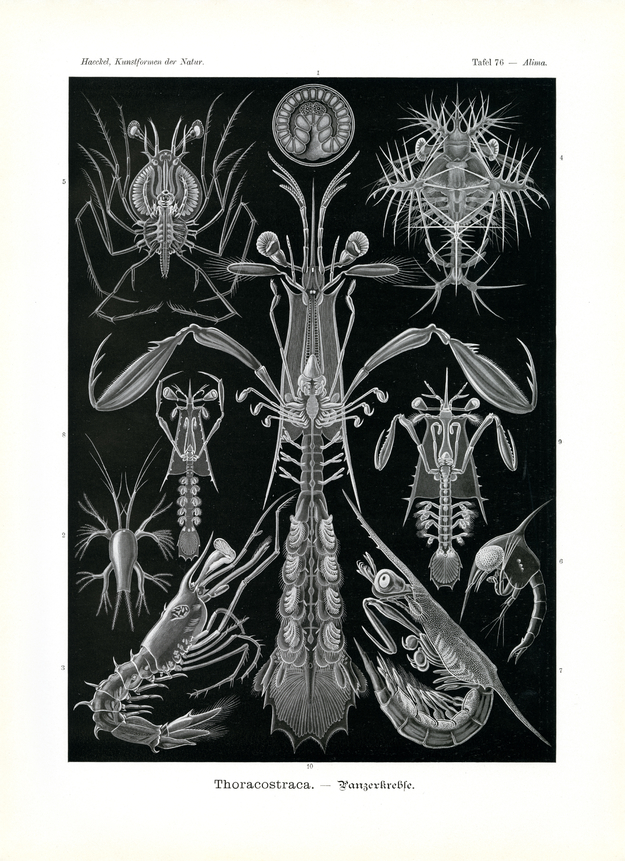Translation of the original German introduction by Ernst Haeckel:
Phylum of Articulata (Gliedertiere); - main class of Crustacea (Krustentiere); - class of Caridonia (Krebstiere); - legion of Thoracostraca (Panzerkrebse).
The legion of crawfish (Thoracostraca) covers the greatest and most highly developed forms of the phylum of crabs, distinguished by a carapace or “head-chest-plate” (Cephalothorax) covering and protecting head and chest from the top. The two orders of decapods (Decapoda) and ‘mouth-pods’ (Stomatopoda) belong here. In spite of all diversity within the numerous individual kinds the organization of the body always remains the same; it is consistently composed of 20 rings or segments, each segment carrying a pair of limbs, the only exception being the last one, the tail part (Telson). Of these 20 rings 5 belong to the head, 8 to the chest, 7 to the abdomen. The same structure is seen in ‘ringed crabs’ (Arthrostraca) which is why they are combined together with the crawfish in the subclass of ‘shell-crabs’ (Malacostraca). In ‘ringed crabs’ alone as well as in ‘flee-crabs’ (Amphipoda) and in woodlice (Isopoda) eyes are located ‘in’ the head (‘sitting eyes’, Edriophthalma); the huge, composed eyes of crawfish, on the other hand, are fixed on long, freely movable stalks (‘stalked eyes’, Podophthalma).
Among the two orders of crawfish the by far most varied is the one of the ‘ten-footed’ (Decapoda, fig. 1-6); all eight ‘breast rings’ have coalesced here; they carry three pairs of ‘jaw-feet’ in front, right behind five pairs of ‘breast-feet’. The long-tailed crabs belong to this group, Macrura (crayfish, lobster, prawn, crawfish) and the short-tailed shrimps (Brachyura, compare plate 86). In ‘mouth-pods’ (Stomatopoda, fig. 7-10), however, the three posterior ‘breast rings’ are free, carrying three pairs of ‘breast-feet’; the five anterior ones carry ‘jaw-feet’.
Most crawfish experience a series of peculiar transformations during the early stages of their development; these metamorphoses are expressed in most considerable transmutations of the peculiar larva shape. Our plate illustrates such larva only, namely, fig. 1-6 of decapods, 7-10 of ‘mouth-pods’. In common crawfish (Astacus) and a few others this metamorphosis is absent due to a shortened period of development; the young ones hatch from an egg already well developed.
Translation by VR Translators Bangalore
We've scanned the original lithography at 1200dpi on the Epson A3 scanner of A3 scanner huren. You can download a 400dpi JPEG here.
